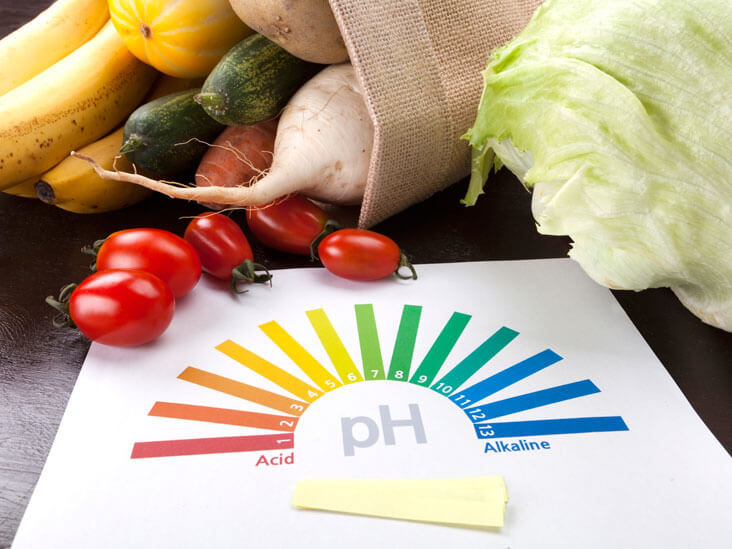Acid-base Balance - What Is It?
The human body functions best when there is a proper acid-base balance in your blood.
A healthy blood pH balance of acidosis and alkalosis is referred to as the acid-base balance. The acid-base balance is measured by a pH scale. The scale ranges from 0 (strongly acidic) to 14 (strongly alkaline). A normal range of 7.35 -7.45 is the human body's ideal pH to allow for biological processes to happen.
Acidosis - occurs when there is too much acid in your bodily fluid for your kidneys and lungs to balance.
- Symptoms of acidosis may include fatigue, headache, rapid or shallow breathing, lack of appetite, increased heart rate, confusion, jaundice
Alkalosis is the result of having too many bases. Alkalosis may be caused by decreased blood levels of carbon dioxide, which is an acid. Alkalosis may also be caused by increased blood levels of bicarbonate, which is a base.
- Mild symptoms of alkalosis may include numbness, hand tremors, muscle twitching or spasm, nausea.
- Severe symptoms may include difficulty breathing, dizziness, confusion or coma.


The human body is tightly regulated to maintain a normal pH range and employs mechanisms to prevent acid-base imbalances. For example, a surplus of acid is a normal byproduct of the metabolic process. However, the body compensates by using defence mechanisms to maintain acid-base balance. Even a minor deviation in the blood's acid-base balance can negatively affect organs. The lungs, kidneys and buffer systems are the main regulators of acid-base balance and are mechanisms used to prevent acid-base disturbances.
The Lungs
Cells require oxygen to survive. As cells process oxygen, carbon dioxide is produced as metabolic waste. Carbon dioxide is the end product of carbonic acid (H2CO2). Carbon dioxide is mildly acidic and passes from the cells into the blood. The blood then carries carbon dioxide back to the lungs, where it is exhaled. The lungs prevent acid-base disturbances by releasing carbon dioxide (CO2). As carbon dioxide accumulates in the blood, the pH of the blood decreases and acidity increases.
The brain detects the amount of pH in the body and reacts by controlling the breath. As breathing becomes faster and deeper, the amount of CO2 exhaled increases. The pH of the blood also increases.
Essentially, by regulating blood flow and breathing, the brain and lungs are able to maintain the acid-base balance and equilibrium by the minute.
The Kidneys
The kidneys play an important role in stabilizing blood pH equilibrium through the excretion of excess acid or base. Their first function is to reabsorb bicarbonate (HCO3) from urine. In order to reabsorb bicarbonate (HCO3), a series of reactions take place in the tubule lemen and tubular epithelium. To regulate acidosis, the tubular cells reabsorb a greater amount of bicarbonate (HCO3) from the tubular fluid. As a result, the duct cells stimulates the excretion of more hydrogen and the creation of more bicarbonate (HCO3). This increases the formation of NH3 buffer.
The second function of the renal physiology is to excrete hydrogen ion through urine. To regulate alkalosis, the kidneys decrease hydrogen ion secretion from the tubular epithelial cells in order to excrete more bicarbonate. This lowers the excretion rate of glutamine metabolism and ammonium.
The renal regulation of the body's acid-base balance is slower than the lungs to compensate for blood pH changes. The kidneys generally take hours to days to compensate for acid-base imbalances and return to homeostasis.
The Buffer System
Chemical buffer systems are extremely efficient in responding to sudden shifts in the acid-base balance and maintaining a normal range in pH. The buffer system is made up of naturally occurring weak acids and weak bases. The buffer system includes a bicarbonate-carbonic acid buffering system, intracellular protein buffers, and phosphate buffers in the bone. Within a fraction of a second, they chemically regulate plasma pH within a normal range. They do so by adjusting the proportions of a weak acid and a weak base. The primary buffer systems are carbonic acid (a weak acid formed when carbon dioxide is dissolved in the blood) and bicarbonate ion (the related weak base)
4 Types of Acid-Base Disorders that Cause pH Imbalances
1. Metabolic Acidosis
The acid-base disorder refers to a metabolic issue with the kidneys. Metabolic acidosis is caused by a build-up of high acidic levels in the blood. It is also caused by decreased acid excretion and gastrointestinal or renal bicarbonate (HCO3) loss. A sign of metabolic acidosis is low bicarbonate levels in the blood. Common causes of metabolic acidosis may include lactic acidosis or loss of bicarbonate through severe diarrhea (less than 22mmol/l). Other causes include ketoacidosis, renal failure, toxic ingestions or severe dehydration.
2. Metabolic Alkalosis
This acid-base derangement occurs when bicarbonate (HCO3) is increased or accumulates, usually as a result of your blood being too alkaline. This accumulation in the kidneys may also be due to acid loss, alkali administration, renal bicarbonate (HCO3) retention or intracellular shift of hydrogen ion. Metabolic alkalosis is most commonly caused by the use of diuretics or volume depletion due to recurrent vomiting or nasogastric suction).
3. Respiratory Acidosis ion
Respiratory acidosis is caused by problems with the lungs and results in a pH that is less than 7.35 and PaCO2 above 45 mm Hg. It occurs when respiratory rates and/or volumes decrease (hypoventilation) which causes carbon dioxide to accumulate. Respiratory acidosis is commonly caused by an impaired respiratory drive (central nervous system disease) and airflow obstruction (asthma, COPD, sleep apnea, airway edema)
4. Respiratory Alkalosis
This disorder is also caused by the lungs and occurs when there is a reduction in carbon dioxide partial pressure (PCO2) and an increase in pH levels. Hyperventilation results as the respiratory rate and/volume increases. Hyperventilation disturbs the balance between breathing in oxygen and breathing out carbon dioxide. Respiratory alkalosis may be caused by pain, anxiety, a response to hypoxia or increased metabolic demands (fever).
Each of these conditions is normally caused by an underlying disease or disorder and treatment depends on the cause.
Compensating for imbalances
To regain acid-base balance and homeostasis, the lungs may respond to metabolic acidosis or metabolic alkalosis, and the kidneys may respond to respiratory acidosis and respiratory alkalosis. If pH remains abnormal, the respiratory or metabolic response is called partial compensation. If the acid-base returns to normal, the response is called complete compensation. The respiratory or renal system will never overcompensate. Treatment often requires identifying the acid-base derangement and, if possible, administering therapy to the underlying causal process.
Basentabs pH balance
To get back to a healthier balance, try Basentabs pH balance. A recent survey (May 2018) of 600 people found the following results:
- 70% of the testers feel generally more alert and energetic when taking Pascoe Basentabs
- 31% of the testers even find that their skin looks healthier after taking the tablets than before
- 84% of the testers were able to detect a change in their pH value using the test strips that come with the product
92% of testers would recommend Basentabs pH balance.






